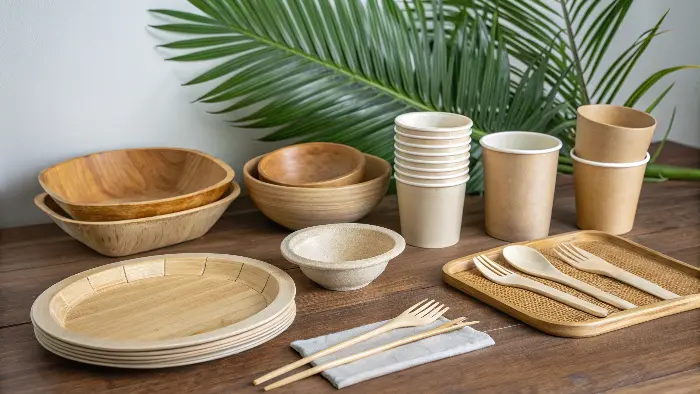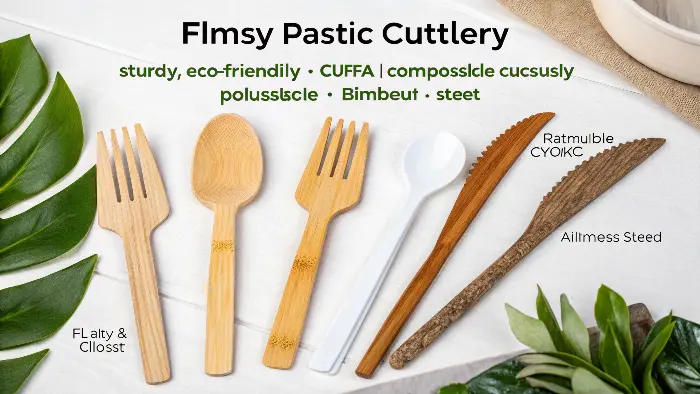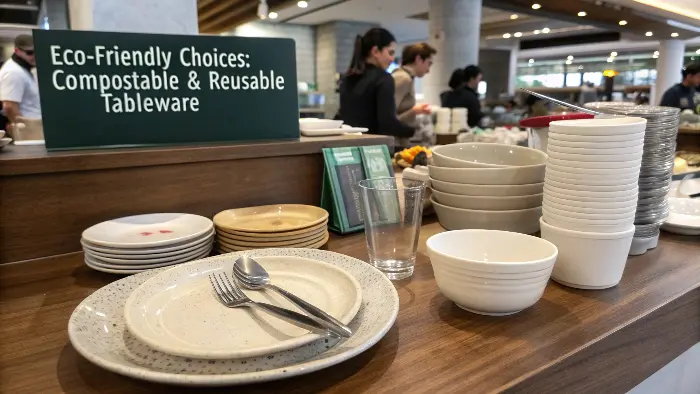Tired of flimsy plastic plates and cutlery harming our planet? It’s a real problem. Discover fantastic, sustainable options that make dining better for everyone!
The top eco-friendly alternatives to plastic tableware include bamboo, palm leaf, bagasse (sugarcane), wheat straw, and stainless steel. These options offer biodegradability, compostability, reusability, and a reduced environmental footprint, making your meals greener.
You know, every time I see a picture of a beach littered with plastic forks or a park bin overflowing with plastic plates after a picnic, my heart sinks a little. It’s a massive issue, and as someone who’s passionate about sustainable solutions with Ecosourcecn, I’m always looking for better ways. Jacky, our eco-conscious packaging specialist in Canada, is constantly on the hunt for these too. The good news? There are some truly amazing alternatives out there that don’t just look good but are way kinder to our planet. It’s not just about avoiding plastic; it’s about embracing materials that work with nature. Let’s explore some of these – I think you’ll be surprised at how cool they are!
What Tableware is Truly Environmentally Friendly Anyway?
Confused by all the "green" claims for tableware? It’s hard to know what’s genuinely eco. Let’s break down what makes tableware truly sustainable.
Truly environmentally friendly tableware comes from renewable resources, is biodegradable or compostable, non-toxic, and produced with minimal environmental impact. Reusable options also rank high for sustainability due to their long lifecycle.
!
It feels like "eco-friendly" is slapped on everything these days, doesn’t it? So, what are we really looking for when we talk about sustainable tableware? For me, it boils down to a few key things. First, where does it come from? Ideally, it’s made from renewable resources – stuff that grows back, like plants, rather than finite resources like petroleum (which is what plastic is made from). Think bamboo, or even agricultural byproducts like sugarcane fibers.
Then, what happens to it after you’re done? This is a big one. Can it break down naturally and return to the earth without causing harm? That’s where terms like "biodegradable" and "compostable" come in. "Biodegradable" means it can be broken down by microorganisms, but "compostable" is even better – it means it will break down into nutrient-rich compost under specific composting conditions, usually in an industrial facility for things like PLA, or even in your home compost for others.
We also need to think about how it’s made. Does the manufacturing process use a ton of energy or harmful chemicals? The less impact, the better. And, super important: is it non-toxic? We don’t want any nasty chemicals leaching into our food. Finally, reusability is a massive plus. A plate you can wash and use hundreds of times is often a fantastic choice, even if it’s not "biodegradable" in the same way a single-use item is. It’s all about that lifecycle. It’s something we stress at Ecosourcecn – considering the full picture from production to disposal. For instance, our PLA products need industrial composting, and we make sure our clients understand that. It’s about informed choices!
So, What Are the Top Eco-Friendly Materials for Tableware Then?
Ready to ditch plastic but unsure what to choose? There are many great materials. Let’s look at the leading sustainable options for your next meal.
Top eco-friendly materials for tableware include bamboo, palm leaf, bagasse (sugarcane), wheat straw, and stainless steel. Each offers unique benefits from renewability to compostability or durability for reuse.

Alright, let’s get to the good stuff – the actual materials! I’ve seen so many innovative products come through Ecosourcecn, and it’s exciting. Here are my top picks based on what’s out there and what really works:
Our Top 5 Picks:
- Bamboo: Oh, I love bamboo! It’s a fantastic grass (yep, it’s a grass!) that grows super fast without needing much water or pesticides. You can get reusable bamboo fiber plates and bowls, which are durable and lightweight, or single-use bamboo plates and cutlery that are biodegradable and compostable. They have a lovely natural look too. I once used bamboo plates for a big family BBQ, and everyone commented on how sturdy and stylish they were. Much better than flimsy paper!
- Palm Leaf: These are just beautiful. Made from naturally fallen Areca palm leaves, they are pressed into shape using just heat and water – no chemicals! Each plate has a unique, rustic look. They’re surprisingly sturdy, good for hot and cold foods, and are fully biodegradable and compostable, even in your backyard compost. I find them perfect for outdoor events or when you want something a bit special but still disposable.
- Bagasse (Sugarcane): This is a real hero material. Bagasse is the fibrous pulp left over after sugarcane stalks are crushed to extract their juice. So, it’s an agricultural byproduct – talk about upcycling! Bagasse tableware is strong, grease-resistant, microwave-safe (a big plus!), and fully compostable. We offer a lot of bagasse products at Ecosourcecn, like clamshell containers and plates, because they’re just so versatile and perform really well.
- Wheat Straw: Similar to bagasse, wheat straw is another agricultural byproduct – the stalk left over after wheat grains are harvested. It’s turned into sturdy, lightweight tableware that’s microwave and freezer safe. It’s also biodegradable and compostable. I think it’s a great example of using something that would otherwise go to waste.
- Stainless Steel: For reusability, you can’t beat stainless steel. Think camping cutlery or those cool tiffin boxes. It’s incredibly durable, easy to clean, non-toxic, and will last practically forever. While the initial production has an environmental footprint, its long life means it often wins out over single-use items in the long run. I always keep a set of stainless steel cutlery in my bag to avoid plastic when I’m out.
Other great options include glass (infinitely recyclable, great for home use) and food-grade silicone (durable, flexible, good for kids’ tableware or reusable food covers). The key is choosing what fits your needs while keeping the planet in mind!What’s the Best Alternative to Flimsy Plastic Cutlery?
Tired of plastic forks snapping in your food? It’s frustrating and wasteful. Let’s find sturdy, eco-friendly cutlery options that actually work.
The best alternatives to plastic cutlery depend on use: compostable options like CPLA or wood for single-use, or reusable choices like bamboo or stainless steel for durability and long-term sustainability.

Ugh, plastic cutlery! It’s the worst, isn’t it? Flimsy, prone to snapping, and a nightmare for the environment. I’ve definitely had my share of "fork-tastrophes" at picnics. Thankfully, there are much, much better options out there now.
If you need a disposable option, CPLA (crystallized polylactic acid) cutlery is a strong contender. PLA is a bioplastic made from plant starch (like corn), and CPLA is a heat-resistant version, making it sturdier than regular PLA and suitable for hot foods. It’s commercially compostable, which is important. We provide these to many food service clients through Ecosourcecn, and they appreciate the performance.
Wooden cutlery (often birch or bamboo) is another popular disposable choice. It’s biodegradable, compostable, and has a nice, natural feel. It’s pretty strong too, though maybe not for tackling a really tough steak! I find it’s great for most everyday meals on the go.
For reusable options, bamboo cutlery sets are fantastic. They’re lightweight, durable, and often come in a little travel pouch. I have a set I carry everywhere – it’s so handy. And, as I mentioned before, stainless steel cutlery is the king of reusability. A good quality stainless steel fork and knife will last you a lifetime. It’s what most of us use at home, so why not for out and about too? Some people even carry a "spork" – a clever spoon-fork hybrid.
The "best" really depends on the situation. For a big event where washing up isn’t feasible, compostable CPLA or wood is great. For personal use, a reusable bamboo or stainless steel set is ideal. The main thing is to move away from that single-use petroleum-based plastic. It just makes sense, and your food (and the planet) will thank you for it!
How Can Restaurants Realistically Ditch Plastic Tableware?
Restaurants face unique challenges in going green. Worried it’s too hard or costly? Discover practical, eco-friendly tableware solutions for food businesses.
Restaurants can ditch plastic by opting for compostable single-use items (bagasse, CPLA), reusable tableware (glass, ceramic, stainless steel for dine-in), and by educating customers about their sustainable choices. Partnering with eco-suppliers helps.

Switching from plastic tableware can seem like a big leap for restaurants, especially when they’re trying to manage costs and busy services. But I’ve seen so many businesses make the change successfully, and it’s definitely doable! It often starts with a mindset shift.
For dine-in, the most sustainable option is almost always reusable tableware: classic ceramic plates, glass Carafes, and stainless steel cutlery. Yes, there’s washing involved, but the lifespan is so long, and it creates a much nicer dining experience. I always appreciate it when a restaurant uses real stuff; it just feels better.
For takeaway and delivery, which is a huge area for single-use items, things get a bit more complex. This is where materials like bagasse (sugarcane) containers truly shine. They’re sturdy, handle hot and greasy food well, and are compostable. CPLA cutlery is a great partner for these. We work with many restaurants at Ecosourcecn to supply these exact items. Some restaurants even offer a small discount if customers bring their own reusable containers for takeaway – a brilliant idea!
Another angle is to rethink what’s actually necessary. Do you really need to give a plastic straw with every drink? Or a plastic lid for a coffee cup if someone’s drinking it right away? Simply asking the customer can cut down on a lot of waste.
Communication is also key. If a restaurant makes the switch, they should shout about it! Let customers know why they’ve chosen eco-friendly options. Most people are really supportive of businesses trying to do the right thing. Jacky, in his role sourcing for his Canadian brand, always looks for suppliers who can clearly communicate the benefits and proper disposal methods of their eco-products, and that’s what we aim for too. It might mean partnering with a commercial composting service if the local infrastructure supports it. It’s about finding solutions that work operationally and financially, while making a positive impact. It’s not always easy, but it’s definitely worth it.
Conclusion
Switching from plastic tableware is easier than ever. Choose from bamboo, palm leaf, bagasse, wheat straw, or steel for a greener, classier, and more responsible dining experience.


